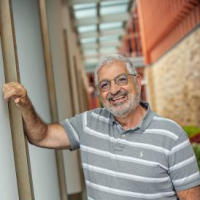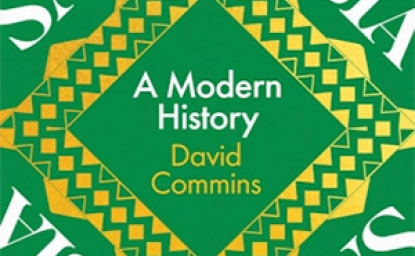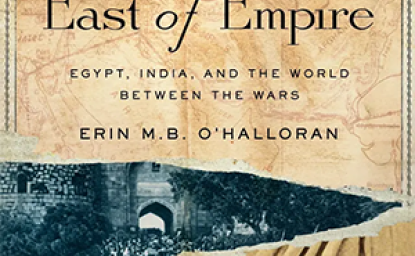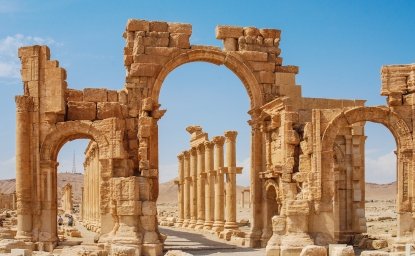Eliminating an Existential Threat: the Armenian Genocide, 1915-1916


Interview with Ronald Suny, Kennan Institute Title VIII Short-term Scholar, and Professor of History, University of Michigan, on August 11, 2014. Kennan Institute Project "The Armenian Genocide, 1915-1916."
Malinkin: Can you talk a bit about why the Turkish government perceived the Armenians and Assyrians as a threat, and why they chose such an extreme approach to handle them?
Suny: That is the central question of my forthcoming book. There is a tendency on the part of some scholars - particularly Armenians - not to try to explain the genocide because – “why do you need to explain it? These are Turks, this is what they do, and this is the kind of regime it was.” Or, slightly more sophisticated – “oh, it's Christians and Muslims – they are inevitably in conflict.” Or — “it's clashes of nationalism.” Now for me, religion, nationalism, the nature of Turkish culture, Ottoman society, the state - all of these are the questions to be asked, not the answers. That is, they need to be investigated. The way I would explain this genocide, and I think it has relevance for other kinds of ethnic cleansings and mass killings, is that the regime developed what I call an “affective disposition” - that is, an emotional understanding of who the enemy was. They constructed the Armenians as an existential threat to the Ottoman Empire and to the Turkish nation, what they conceived as the Turkish nation at that time. I try to explain the origins of this affective disposition - this mental universe - in which emotion, fear, anger, and resentment combined to create an image of Armenians. Armenians originally had been thought of as a loyal millet, but after 1878 the Armenians became an instrument of certain foreign powers to intervene in the Ottoman regime and internal policy — the Ottomans began to see them as a threat.
Remind us what happened in 1878.
This was the Russian-Turkish War of 1877-1878. The Russians beat the Turks, and they were going to impose reforms on the Ottoman Empire, and that was the beginning of the new “Armenian question” that continued right up to the war. Now, some people would say "well, you don't need to go into emotions - it was a perfectly strategic, rational choice. The Armenians were actually a threat in World War I, and the Turks decided to get rid of them for national security reasons.” My view is that's an insufficient explanation. Why did they see them as a threat? A threat is always a perception. It's about emotion, it's about understanding, feeling, sentiment, and construction - both cognitive and emotional construction. I'm taking a step backwards to see how they got into the position that they could imagine people this way and then carry out the worst possible kinds of things. I’m bringing emotion into it.
By some accounts, Armenians sided with Russia at the beginning of World War I —was that something the Ottomans could point to that the Armenians were a threat?
This is the problem. You can't say the Armenians sided with Russia. That is what the Ottomans would say, and they perceived that. So there are people who try to justify what the Ottomans did to the Armenians by saying they were with the enemy. What I try to show in the book is that the overwhelming majority of Ottoman Armenians wanted to stay in the Empire, but they also wanted reforms to protect them and allow them to prosper. They wanted Kurdish predations against Armenians to be contained, for example. The Ottoman government was opposed to these reforms, but ultimately had to agree to them in February 1914. When the war came, though, they used the first opportunity to get rid of them. I’ll give you an example. As the Ottomans are going to war, they mobilize the population. Hundreds and thousands of young Armenian men are drafted and join the Ottoman army. A few desert and go over to the Russian side. Some prominent leaders go over to the Russian side. The Russians form Armenian voluntary units on the Caucasian side against the Ottomans, but the Turks see this as treachery and demobilize hundreds of thousands of Armenian soldiers, take their weapons and uniforms away, turn them into labor battalions, and eventually murder them. So it's a very different thing. It's not that there wasn't sympathy among some for Russia, but there was also no particular love for Russia. Russians didn't like the Armenian nationalist revolutionaries any more than the Turks did so they were persecuting them as well. The Armenians were in an unfortunate position - in Persia, in Russia, and in Turkey. They were like the Kurds today.
What other situations in history would you say are the most comparable to the Armenian genocide?
Genocide, luckily, is a very rare phenomenon. That is, genocide, the physical elimination of a designated people, that is a cultural, ethnic, religious group. The Holocaust, the Armenian genocide, Cambodia – there are very few events that fit my tight definition. Other people have loosened that definition to mean all examples of mass killing. I don’t do that. I limit it because then you can try to explain it. But, the arguments for state security, and the emotional construction of enemies that have to be eliminated is rampant.
There are so many similar situations. I try not to overdraw historical similarities, but some of the rhetoric that was used in the Armenian genocide –“the Armenians are the reasons for their own destruction, they're guilty and therefore they should be punished, etc.” I find being repeated about Palestine: “No, it's Hamas that's bringing these bombs down on themselves,” for example. This shows a lack of understanding that if you push people to a certain extent, they will resist, that there's a dynamic at work here. The Armenians ultimately did resist in a few places - in Urfa, on Musa Dagh, the well-known site of resistance that the novel was written on, and in Van, most importantly in April 1914. People were being massacred, and they resisted. Then the Turks said “oh, they revolted, they're pro-Russian.” In the city of Van, they were waiting for the Russians to come because they were being destroyed.
Palestine was not an example of genocide, but it was certainly an example of ethnic cleansing which is still probably going on to some extent. But this is another case where the Israelis see an existential threat from Palestinians, and the Palestinians, as an occupied and colonized people, clearly see the Israelis as the enemy. That’s another important point - Armenians in 1915 attempted to prove to the Turks that they were loyal.
How did they try?
They mobilized their young men to fight in the army, they raised money for hospitals and aid to the government, they spoke in favor of the war effort, and many other things. They told them - we're loyal, don't push us into opposition. But there was an imbalance of agency. You see this today in the Armenian and Azerbaijani conflict over Karabakh, or the Israel-Palestine conflict. One side has more power and has more cards to play: the Israelis in the case of Palestine, the Armenians in the case of the Armenian- Azerbaijani conflict, and the Ottomans in 1915. The Armenians had what I’d call a dilemma of the damned. As they were being constructed as the enemy, there was very little they could do. And then they were disarmed, their leaders were arrested, they were systematically deported, and many hundreds of thousands were murdered.
The Ottoman Turks mobilized the population, in a completely chaotic and disorganized way, and there was dislocation, food shortages, soldiers marching hundreds of miles to get to the front. They were inadequately equipped, and huge numbers of desertions took place. There were half a million deserters, Muslims as well as Christians and others. Many of those deserters would either pillage villages for food, rape women, or clash with the army, and the Ottoman government claimed these were Armenian revolts. A lot of soldiers deserted, and it was general chaos.
To what extent did ordinary people participate or was it mostly carried out by special military forces?
Yes, let’s talk about the perpetrators, who they were. Genocides are ordered from the top: secret orders go out that say “take care of these people” (start the deportations), but we don’t have very good records on that. The orders bring about massacres, and in a systematic way. In the Armenian genocide, the deportations and massacres were often carried out by nomadic Kurds, Circassians (or, Cherkess, as they're also called), Chechens — many of them refugees from the Caucasus or the Balkans, so called Muhacirs, other refugees who were to be settled in the Armenian villages, and ordinary people, even women. We have reports of women cutting down people so there is some popular participation.
One problem I have is - how much did the Ottomans understand what they were doing, and how much did they believe in it? There were some Ottoman governors who refused to carry out the killings and the deportations. And there were Turks and Kurds who took Armenian refugees into their homes, sometimes forcibly making women part of their harem or family, converting them to Islam. But others believed in the necessity of the massacre. You can now access intelligence reports, and certain commanders were sending reports of Armenian insurrections. Some scholars have read these reports — a kind of new, sophisticated denialism — and taken the Ottomans at their word that there really was a revolt. There wasn't. There was no coordinated, general insurrection of Armenians during the war. There were individual moments of resistance, as at Van or Musa Dagh, because they were being attacked. This is a good parallel to some of the current events. History is useful, isn't it?
Along with the killings and deportations, did the Turks foment general anti-Armenian sentiment throughout the empire? Did regular people begin to hate Armenians?
The Armenians in the Empire were distinct — religiously distinct, as well as culturally and linguistically in many cases. They were also Ottomans, so they were part of this society. Many Armenians even spoke Turkish and not Armenian and so forth, but at least you could identify who they were - they went to different churches and clubs, etc., and they lived in concentrated areas, but at a certain point, resentment developed against Armenians who were better off, more closely tied to Europe, and better educated. Then as the propaganda about Armenians developed, and about Greeks too, that they're linked to foreigners, that they're a threat to the country, etc., more and more people begin to turn against them. So eventually this fear, anger, and resentment became hatred.
Were the Chechens and Circassians specially sought out for the killings or were they already living in the Empire?
There had always been clashes between Kurds and Circassians and Armenians about land so there was a base of hostilities and tensions. The Ottoman government would often recruit them into special organizations, which hired them as well as criminals and others into gangs, and these people carried out a lot of massacres. The Kurds today, in the Republic of Turkey, are one major group who recognize the genocide, who have apologized for what they did, who believe they were used by the Turks, and they are trying to make up for that now. For example, in the city of Diyarbakir, where my grandmother is from, the local Kurds have opened churches and talk about living in the land together with Armenians. It's amazing what they're doing. My daughter Anoush is living with a Kurdish family right now in the city of Van, where her mother's family came from.
So the Kurds have tried reconciliation?
Yes, because they also feel persecuted by the Turks. Kurdish discourse is something like “they had you for breakfast, and they're going to have us for dinner.” I really think Turkey is the country to watch. Something's happening there, and we don't know where it will go. We don't know where Russia or Armenia will go either, so keep your eye on them.
You mentioned before that Armenians began to view themselves as a nation during this period - could you talk about how the genocide contributed to that process? What caused the growing sense of a nation?
I'm a constructivist — I believe that nations are creations of human beings. At a certain point people begin to think of themselves as a nation rather than a religious group or other identity, and this happened for the Armenians in the 19th century. Turks began to think this way a bit later, more in the 20th century, and Kurds even later than that. The genocide happened at a time when some people were thinking in this nationalist idiom, but simultaneously, many others were thinking of themselves as Ottomans, with special Armenian characteristics. Armenian nationalism in a sense won the day in World War I, and the post-war period, until, of course, the Soviets took over the Armenian republic, and nationalism became an alien ideology that couldn't be expressed openly. It then became the ideology of the diaspora.
The Assyrians are also part of your book - were they seen as a distinct group from the Armenians at that time?
They saw themselves as distinct groups, but the Assyrians, who as another Monophysite Christian group, were often identified with Armenians. Some of them were part of Ermeni Milleti, the official Armenian community, and they were also perceived to have links with foreigners. So the Assyrians were somewhat outcasts, both in Persia and in the Ottoman Empire, and they also suffered tremendously.
Tell us about the Henry Morgenthau papers – what they contain and how they contribute to your research.
Henry Morgenthau was a wealthy Jewish American who was a major supporter of Woodrow Wilson who appointed him ambassador to Istanbul (Constantinople). Morgenthau was reluctant because this was seen as “the Jewish post,” but he decided to go anyway. He arrived and the war breaks out and the Armenian genocide takes place. Meanwhile, Ambassador Morgenthau became very close friends with Talaat Pasha, the minister of the interior in Istanbul, who's the major architect of the genocide. They would go riding together. On April 24, 1915 Talaat invited him to dinner, and that's the night that they arrest the Armenian intellectuals. So while Morgenthau was sending dispatches back to the State Department he also kept a diary, which he eventually had published as a book called Ambassador Morgenthau's Story. This book became the major template of the way people understood the genocide. In my work I’m trying to examine what he's actually saying, what we can take as true, and what we have to understand as part of the prejudices of the time. It was very controversial, but it's an important and devastating book. As one Holocaust scholar said, we have nothing like it in Holocaust studies, where the actual perpetrators talked to someone and told what they were doing. It’s quite extraordinary.
Mary Elizabeth Malinkin
Matthew Rojansky, Director, Kennan Institute
Authors

Kennan Institute

The William H. Sewell, Jr. Distinguished Professor of History, University of Michigan

Kennan Institute
The Kennan Institute is the premier US center for advanced research on Eurasia and the oldest and largest regional program at the Woodrow Wilson International Center for Scholars. The Kennan Institute is committed to improving American understanding of Russia, Ukraine, Central Asia, the South Caucasus, and the surrounding region through research and exchange. Read more




